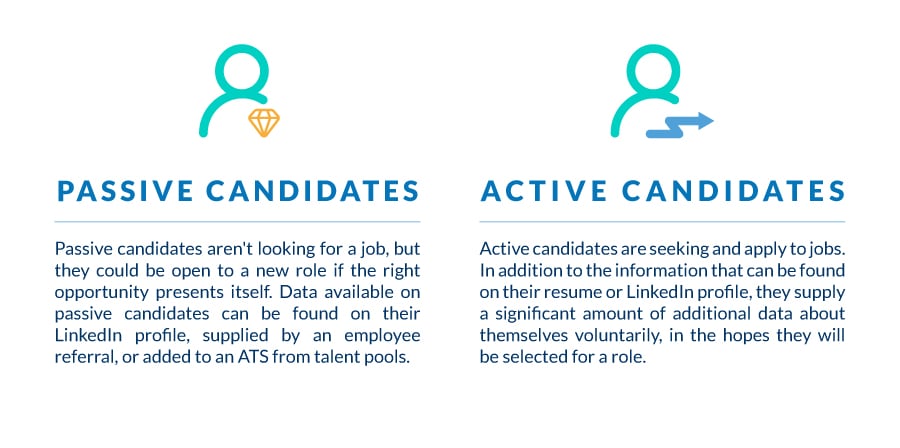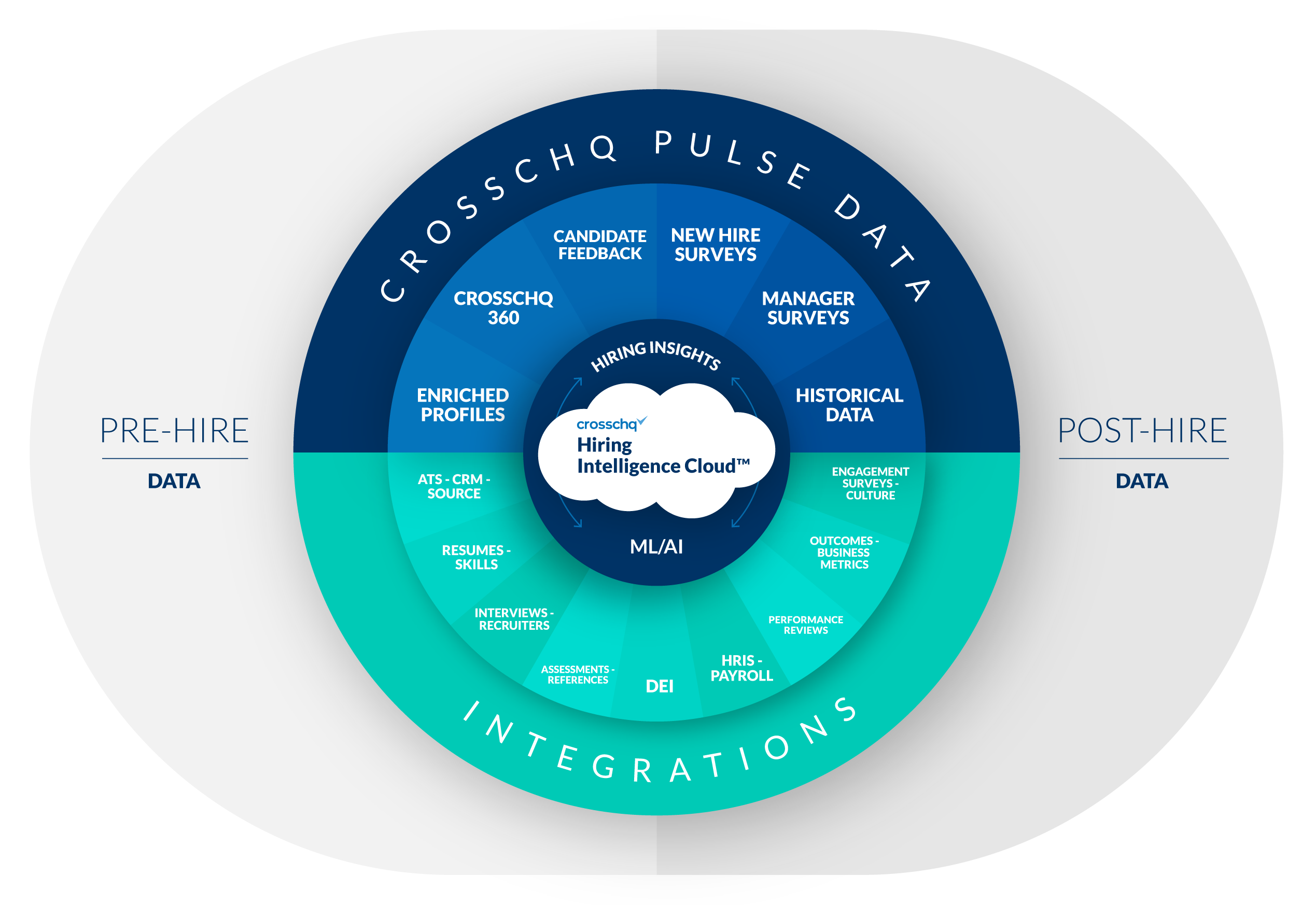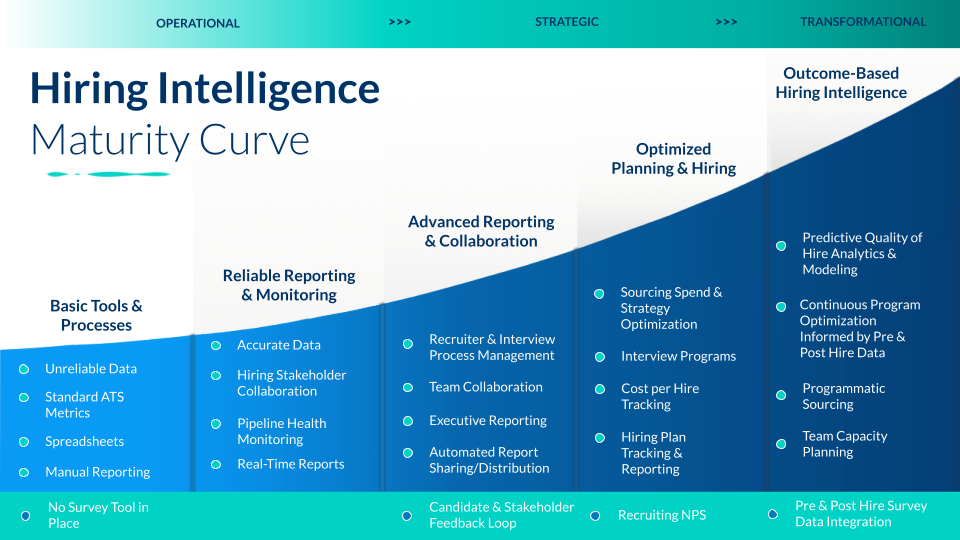

Crosschq Blog
The Definitive Guide to Hiring Intelligence

Recently published research from Deloitte revealed that 83% of companies surveyed globally have low people analytics maturity for talent acquisition. According to the report, organizations are under-equipped to identify problem areas. "Addressing this capability gap is a business imperative..."
.jpg?width=900&height=222&name=Hiring%20Intell%20Pillar%20Post_Deloitte%20(1).jpg)
Simply put, even some of the smartest organizations are struggling to use data and insights to make better hiring decisions. That’s where Hiring Intelligence comes in.
Hiring Intelligence is the new buzzword popping up in discussions around talent acquisition. But exactly what IS Hiring Intelligence, and how can it be leveraged to achieve business goals?
What Is Hiring Intelligence?
The simple definition of Hiring Intelligence is the use of data and analytics to continuously inform and optimize the entire hiring process. That sounds complicated, but it’s easy to understand when broken down:
The use of data and analytics…
Data that is ripe for analysis comes from the candidates themselves, recruiters, internal datasets related to diversity, and the hiring funnel process. Recruitment strategies and tactics can also be analyzed to gain deeper insights into what’s currently working and what is not.
…to continuously inform and optimize…
Hiring Intelligence is a closed-loop system that talent professionals can use to constantly learn and improve. Hiring decisions will become more informed with each iteration, making it easier to identify, attract, and recruit the best candidates.
…the entire hiring process.
Using data and analytics to optimize the hiring funnel doesn’t happen at a single touchpoint. Instead, Hiring Intelligence is fully integrated into the recruitment pipeline, involving every part of the hiring process from both the candidate’s and recruiting team’s perspectives.
.jpg?width=900&height=712&name=Hiring%20Intell%20Pillar%20Post_HI%20defined%20(1).jpg)
According to the Data and Analytics Leadership Annual Executive Survey 2023, the business value of data and analytics investments is of top interest for leaders across most major industries. According to the Executive Summary:
“Just 23.9% of companies characterize themselves as data-driven, and only 20.6% say that they have developed a data culture within their organizations, reflecting that becoming data-driven is a long and difficult journey that organizations increasingly recognize playing out over years or decades.”
Moving Faster to Data-Driven Hiring
Implementing Hiring Intelligence is a huge step in the right direction for companies that want to bring their recruitment processes forward and remain competitive. Making an impact by integrating data-driven decision-making can be done fairly quickly and intuitively if you have the correct tools and support. Crosschq’s suite of Hiring Intelligence tools are designed to move you swiftly and confidently into the future of hiring.
You might also like: The Hiring Intelligence Fast-Track Series
Read post 1 here: Do you have the right data to win the hiring battle?
Artificial Intelligence in Hiring is NOT Hiring intelligence
While artificial intelligence (AI) tools can be extremely helpful for automating and streamlining recruitment pipelines, AI is not the same as Hiring Intelligence. Both are data driven, but Hiring Intelligence uses human responses to generate data and feed a life cycle of constant improvement, while AI alone can easily get caught in loops of iteration based on inaccurate or incomplete data.
AI can be used as a tool to make hiring funnels run more smoothly, but it has a long way to go before it will be personalized and “human” enough to independently surface and source the right candidates for the right jobs. Hiring Intelligence, however, is ready in the here and now to do exactly that.
The Benefits of Hiring Intelligence
Hiring Intelligence can be leveraged throughout the hiring process to enhance results at every stage of the funnel. It makes talent acquisition a strategic part of the business that directly impacts the bottom line, inherently giving HR and TA leaders a seat at the table.
.jpg?width=900&height=583&name=Hiring%20Intell%20Pillar%20Post_Benefits%20Journey%20(1).jpg)
Hiring Intelligence helps organizations to:
Optimize recruiting efforts by making it easier to find, source, and hire top talent across all job boards and platforms.
↓
Reduce hiring and sourcing costs by identifying which channels deliver the most value, allowing energy and budget to be trained on the highest-performing options.
↓
Save time for recruiters and hiring managers by achieving agreement as to what the ideal candidate looks like, for better clarity throughout the process.
↓
Continuously improve hiring processes by providing a clear picture of how different methods of sourcing, refining, interviewing and hiring stack up against each other and highlighting areas that can use improvement.
↓
Increase Quality of Hire across the organization by delivering the best candidate for every job, every time, and iteratively learn .
The Data That Goes Into Hiring Intelligence
Data can be collected at various touch points along the candidate journey. This process may start before a candidate is even actively involved in the sourcing process.
Candidate Data for Intelligent Hiring
Data is more immediately available on some candidates than others:

Actively Seeking Passives
According to LinkedIn, 70% of the global workforce is passive talent, with around 30% actively seeking jobs.
Although opinions vary as to passive candidate quality compared to active candidates (many say passive candidates are superior, others claim it's not so), any strong recruiting strategy should include seeking out passive candidates or there's risk of missing out on potentially some of the best talent out there.
Sourcing on LinkedIn or other sites can be cumbersome and time consuming, requiring a big pipeline of outreach to garner enough responses since this talent pool is much more difficult to engage. There are some AI sourcing tools available to automate or assist in this process. In addition, there are alternative sourcing options including live events, participating in talent communities, engaging with talent on social media channels, or looking to internal referrals.
Taking passive candidates to a new level, you can use clever sourcing tactics to fill your pipeline with quality candidates, like using Crosschq Recruit–a proprietary sourcing database filled with qualified talent that has already opted-in to hear more about job opportunities. Although these candidates haven't actively applied for a job directly at your organization, they are open to hearing about new positions, and are highly qualified since they come from a candidate's reference referral network.
Recruiter Data for Intelligent Hiring
Different types of recruiters have ready access to different types of data:
Internal Recruiters
Internal recruiters are typically part of the HR department, and have extra resources and insight into what the job requires. They have access to critical data regarding what skills and attributes must be present in a top candidate, but may be biased in favor of internal referrals, missing out on the more diverse options available in a wider pool.
External Recruiters
Third-party recruitment organizations or independent outside recruiters often have a range of contacts across the industry, and access to data on thousands of potential candidates. They will need data from the employer’s side to better understand what they should be looking for in potential hires and find the best fit for each job posting.
.jpg?width=900&height=544&name=Hiring%20Intell%20Pillar%20Post_Internal-External%20(1).jpg)
Diversity Data for Intelligent Hiring
Unconscious bias is one of the most concerning enemies of diversity in today’s workplace. Hiring Intelligence delivers data on candidates that can be factored in across the hiring pipeline to help ensure recruitment isn’t missing the mark.
Whether a particular group is underrepresented or they are dropping out of the hiring process at certain stages or at a faster speed than others, tools like TalentWall by Crosschq track and cut data by EEOC groups, and can help you highlight important diversity statistics and visually uncover any problem areas or gaps in the hiring process. Read more here about using data to drive more equity, diversity and inclusion in your hiring.
Workplaces that don’t address unconscious bias can end up succumbing to culture fit - leading to a homogeneous work culture where everyone looks, sounds, and thinks alike. The goal should be culture add - leading to a vibrant culture made up of many different types of people, which drives both innovation and higher revenues.
- Age and generation
- Race and ethnicity
- National origin
- Religion or lack thereof
- Disability and ability
- Gender identity, sexual orientation, pregnancy
- Socioeconomic status and background
- Genetic information
Process Data for Intelligent Hiring
Different stages of the hiring process yield different types of datasets:
-1.jpg?width=900&height=859&name=Hiring%20Intell%20Pillar%20Post-06%20(1)-1.jpg)
Sourcing
Basic data can be collected from online platforms such as LinkedIn and social media
Application review
As data goes into the ATS, it should be sorted for easy retrieval using Hiring Intelligence.
Pre-hire assessments
Tests, assessments, and reference checks yield data about skills and attributes.
Interviews
The right interview questions can confirm or refute assumptions about candidate fit.
Pipeline management
Tracking candidates through the hiring funnel can yield data that supports KPI optimization.
Post-hire evaluations
Track new-hire performance and survey them regularly to measure employee satisfaction.
Post-Hire Data for Intelligent Hiring
The employee picture is not complete without post-hire data. Organizations use a variety of tools to gather post-hire data on new employees including:
- Engagement surveys
- Business performance metrics
- Payroll
- DEIB
- Assessments
- Reviews and surveys
Tying It All Together with Quality of Hire
The Quality of Hire picture is not complete without closing the loop on an employee's performance. Perhaps new hire interviewed well and showed promise during onboarding, but did they continue to learn, grow and perform over time? Do they fit in well with their team and is the hiring manager satisfied with their ongoing interactions and performance metrics? Is the employee contributing successfully to the company's bottom line?
Integrating the all the data into one tool allows leaders to determine Quality of Hire. By connecting employee performance and other post-hire information to pre-hire data points such as source of hire or assessment scores, recruiting teams can learn and continuously improve their decision-making processes.

You Might Also Like: Can pre-hire data predict post-hire performance?
Read more here.
Hiring Intelligence Metrics For Smart Hiring
Metrics important for Hiring Intelligence include:
Quality of Hire
Quality of Hire is a measurement of an employee's value. It can be calculated using factors like performance, hiring manager satisfaction, culture fit, promotability, and re-hireability. QoH is usually reported as a score or a percentage (download Crosschq’s Quality of Hire ”Q” Report to learn how to easily make these calculations.)

TIP: Use data analytics and surveys to track QoH over time, compare candidates, and make the best possible hiring and firing decisions.
.jpg?width=900&height=544&name=Hiring%20Intell%20Pillar%20Post_Scale%20image%20(2).jpg)
Time to Fill
This metric expresses the time period between when a job requisition is originally opened in the ATS, and when a candidate is ultimately marked in the ATS as hired.

TIP: Use Hiring Intelligence and reporting to get all stakeholders on the same page so the recruitment process moves faster without increasing risk of a bad hire.
Time to Hire
TTH is a subset of time to fill, starting when a candidate submits their resume and ending when the candidate accepts the offer.

TIP: Use TalentWall by Crosschq to identify roadblocks or bottlenecks in the recruitment pipeline and fix them for a smoother application to hire journey.
Source of Hire
This metric separates the percentage of overall hires from each recruiting channel or source, such as job boards, referrals, or direct sourcing.

TIP: Compare source of hire data with post-hire performance data to see where the best hires come from, and focus more efforts on that source.
First-Year Attrition Rate
This is the percentage of employees who quit or are terminated within 12 months of starting their new job. It can also be expressed in reverse as the “candidate retention rate”.

TIP: Review job descriptions and onboarding processes and request that leaving employees (or their managers) complete exit surveys to shed light on potential recruitment issues.
Pass-Through & Drop-Off Rates
Pass-through rates or conversion rates show how many candidates make it from one stage of the funnel to the next. Drop off rates show how many candidates don’t make it.

TIP: Pay special attention to uneven drop-off that highlights an unexpected number of candidates leaving at specific points in the process, and find the trigger.
Cost Per Hire
Cost per hire is the entire cost of recruiting a candidate, including third party recruiter costs.. This should also include indirect costs, such as lower productivity due to an unfilled role, that are incurred during the time to fill/time to hire period.

TIP: Use Hiring Intelligence to improve TTF and TTH without sacrificing QoH, for lowered costs across the board and increased employee retention.
The Hiring Intelligence Lifecycle
To use Hiring Intelligence effectively, map out the hiring process and use data at each touchpoint to optimize and improve recruitment results.
.jpg?width=900&height=678&name=Hiring%20Intell%20Pillar%20Post_Lifecycle%20(1).jpg)
The Hiring Intelligence Process
The reason Hiring Intelligence is so effective is that each round of hiring yields data that can be used to improve the results of the next round. Each data point delivers insights to improve the hiring process. The hiring process delivers new data which can be input and continues feeding the system.
.jpg?width=900&height=544&name=Hiring%20Intell%20Pillar%20Post_Circle%20arrows%20(1).jpg)
The Hiring Intelligence Maturity Curve
Hiring Intelligence has a strong maturity curve. Each phase is more complex than the last, traveling the curve from a flat, unassisted hiring journey to the peak of transformation powered by hiring intelligence.
Level 1: Basic tools and processes in place
Organizations at Level 1 typically lean on spreadsheets and a basic ATS that delivers only standard metrics. Unreliable data and manual reporting compounds the problem, and lack of a survey tool means post-hire follow-up and analysis is impossible.
Level 2: Reliable reporting and monitoring
It only requires a simple layering of data visualization on top of an existing ATS to take organizations to Level 2. With hiring stakeholder collaboration, accurate data, and real-time reporting, pipeline health monitoring becomes easy and intuitive.
Level 3: Advanced reporting and collaboration
Level 3 means there is greater team collaboration, bringing team leaders, recruiters, interviewers and hiring managers closer together for more effective process management. Executive reporting and automated report sharing/distribution creates a high-value candidate/stakeholder feedback loop.
Level 4: Optimized hiring and planning
The shift from merely operational to fully strategic continues in Level 4 with sourcing spend and strategy optimization. Hiring plan tracking and reporting and accurate cost per hire tracking deliver additional insights, while improved interview programs work to increase candidate Net Promoter Scores (NPS).
Level 5: Outcome-Based Hiring Intelligence
At Level 5, Hiring Intelligence becomes completely transformational, with continuous program optimization fueled by pre-hire and post-hire reporting and survey integration. Programmatic sourcing, team capacity planning, and the predictive Quality of hire analytics and modeling work together to attract, hire, and perfect each hire.
Climb the Curve:
Start tracking your data points today and tie them to results with a Hiring Intelligence platform.
Ready to learn more about Hiring Intelligence, and how it can help improve and optimize recruitment processes and hiring decision-making?
Set up a time to chat with us here. Share your current hiring analytics tools and processes with us, and we can help you determine where your organization sits today on the Hiring Intelligence Maturity Curve. We can prepare a customized plan for you to climb the curve and gain recruitment momentum with Hiring Intelligence.
As you can see, Hiring Intelligence has become a hot topic in talent because it allows organizations to quickly and accurately identify and source the right people for the right positions in a data-driven way. Furthermore, it can provide insights into the best talent in the market and can enable employers to make more informed decisions to increase Quality of Hire.
And this is just the beginning. We’re still in the early days of Hiring Intelligence, so join us and catch the wave as we ride it to new heights.
Take the Guesswork
Out of Hiring
Schedule a demo now



%20-200x43.png)







.png)